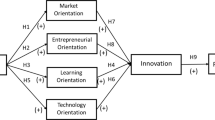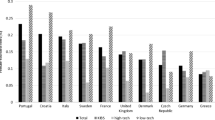Abstract
Research on innovation in the context of small entrepreneurial firms is limited. Limited available studies on innovation in small firms are devoted mostly to firms operating in knowledge-intensive or technology industries and ignore the vast majority of small firms operating in traditional and less knowledge-intensive sectors of the economy. The rapid pace of technological change and the intensifying environmental turbulence in our economy influence all firms, including the majority of small firms that are perishing at a faster rate. Innovation is a key competitive tool for survival in a turbulent environment. Thus, it is important to understand factors influencing innovation in small firms. In this paper, we explore how learning orientation, a small-firm owner’s satisfaction with firm performance, and the firm owner’s gender influence innovation in small firms. We test the proposed model on a sample of small firms located in the United States of America.

Similar content being viewed by others
References
Açıkgöz A, Günsel A, Bayyurt N, Kuzey C (2014) Team climate, team cognition, team intuition, and software quality. Group Decis Negot 23(5):1145–1176
Açıkgöz A, Günsel A, Kuzey C (2016) Team foresight in new product development projects. Group Decis Negot 25(2):289–323
Ahl H, Marlow S (2012) Exploring the dynamics of gender, feminism and entrepreneurship: advancing debate to escape a dead end? Organization 19(5):543–562
Andries P, Czarnitzki D (2014) Small firm innovation performance and employee involvement. Small Bus Econ 43(1):21–38
Baker WE, Sinkula JM (1999) The synergistic effect of market orientation and learning orientation on organizational performance. J Acad Market Sci 27(4):411–427
Bass BM, Avolio BJ (1994) Shatter the glass ceiling: women may make better managers. Hum Resour Manag 33(4):549–560
Bass BM, Avolio BJ, Atwater L (1996) The transformational and transactional leadership of men and women. Appl Psychol 45(1):5–34
Batchelor JH (2015) Exposing the role of gender in the performance of founding entrepreneurs. J Small Bus Strategy 25(2):21–39
Bowman C, Ambrosini V (1997) Using single respondents in strategy research. Br J Manag 8(2):119–131
Breton Miller L, Miller D (2009) Agency versus stewardship in public family firms: a social embeddedness reconciliation. Entrep Theory Pract 33(6):1169–1191
Bromily P (1991) Testing a causal model of corporate risk taking and performance. Acad Manag J 34(1):37–59
Brush C (1992) Research on women business owners: past trends, a new perspective and future directions. Entrep Theory Pract 16(4):5–30
Brush C, Hisrich RD (1999)Women-owned businesses: why do they matter? In: Acs ZJ (ed) Are small firms important? Their role and impact. Springer, Boston, MA, p 111–127
Bunderson JS, Sutcliffe KM (2003) Management team learning orientation and business unit performance. J Appl Psychol 88(3):552–560
Buttner EH, Rosen B (1992) Rejection in the loan application process: male and female entrepreneurs’ perceptions and subsequent intentions. J Small Bus Manag 30(1):58–65
Carmelo-Ordaz C, Garcia-Cruz J, Sousa-Genel E (2014) The influence of top management team conflict on firm innovativeness. Group Decis Negot 24(6):957–980
Carnevale PJ (2008) Positive affect and decision frame in negotiation. Group Decis Negot 17(1):51–63
Carter NM, Williams ML (2003) The case of new firm growth. N Perspect Women Entrep 3:25–50
Carter S, Anderson S, Shaw E (2000) Women’s business ownership: a review of the academic, popular, and internet literature with a UK policy focus. Ann Rev Progr Entrep 1:66–157
Chandy RK, Tellis GJ (2000) The incumbent’s curse? Incumbency, size, and radical product innovation. J Mark 64(3):1–17
Christensen CM, Raynor ME (2003) The innovation’s solution. Harvard Business School Press, Boston
Cohen WM, Levinthal DA (1990) Absorptive capacity: a new perspective on learning and innovation. Adm Sci Q 35:128–152
Cooper AC, Artz KW (1995) Determinants of satisfaction for entrepreneurs. J Bus Ventur 10(6):439–457
Crossan MM, Apaydin M (2010) A multi-dimensional framework of organizational innovation: a systematic review of the literature. J Manag Stud 47(6):1154–1191
Currah A, Wrigley N (2004) Networks of organizational learning and adaptation in retail TNCs. Glob Netw 4(1):1–23
Cyert RM, March JG (1963) A behavioral theory of the firm. Prentice Hall, Englewood Cliffs
Daft RL (1978) A dual-core model of organizational innovation. Acad Manag J 21(2):193–210
Damanpour F, Evan WM (1984) Organizational innovation and performance: the problem of organizational lag. Adm Sci Q 29:392–409
Darnall N, Henriques I, Sadorsky P (2010) Adopting proactive environmental strategy: the influence of stakeholders and firm size. J Manag Stud 47(6):1072–1094
D’aveni RA (2010) Hypercompetition. Simon and Schuster, New York
De Bruin A, Brush CG, Welter F (2006) Introduction to the special issue: towards building cumulative knowledge on women’s entrepreneurship. Entrep Theory Pract 30(5):585–593
De Massis A, Frattini F, Lichtenthaler U (2013) Research on technological innovation in family firms: present debates and future directions. Fam Bus Rev 26(1):10–31
De Winne S, Sels L (2010) Interrelationships between human capital, HRM, and innovation in Belgian start-ups aiming at an innovation strategy. Int J Hum Resour Manag 21(11):1863–1883
DeRue DS, Wellman N (2009) Developing leaders via experience: the role of developmental challenge, learning orientation, and feedback availability. J Appl Psychol 94(4):859–903
Dess GG, Picken JC (2000) Changing roles: leadership in the twenty-first century. Org Dyn 28(3):18–34
Giordano R, Brugnach M, Pluchinotta I (2017) Ambiguity in problem framing as a barrier to collective actions: some hints from groundwater protection policy in the Apulia region. Group Decis Negot 26(5):911–932
Gupta VK, Turban DB, Wasti SA, Sikdar A (2009) The role of gender stereotypes in perceptions of entrepreneurs and intentions to become an entrepreneur. Entrep Theory Pract 33(2):397–417
Hambrick DC, Mason PA (1984) Upper echelons: the organization as a reflection of its top managers. Acad Manag Rev 9(2):193–206
Hamel G (2000) Leading the revolution. Harvard University Press, Cambridge
Hillman AJ, Cannella AA, Paetzold RL (2000) The resource dependence role of corporate directors: strategic adaptation of board composition in response to environmental change. J Manag Stud 37(2):235–256
Hisrich R, Brush C (1984) The woman entrepreneur: management skills and business problems. J Small Bus Manag 22(1):30–37
Hmieleski KM, Ensley MD (2007) A contextual examination of new venture performance: entrepreneur leadership behavior, top management team heterogeneity, and environmental dynamism. J Org Behav 28(7):865–889
Hult GTM, Hurley RF, Knight GA (2004) Innovativeness: its antecedents and impact on business performance. Ind Mark Manag 33(5):429–438
Hurley RF, Hult GTM (1998) Innovation, market orientation, and organizational learning: an integration and empirical examination. J Mark 62(3):42–54
Ilgen DR (1971) Satisfaction with performance as a function of the initial level of expected performance and the deviation from expectations. Org Behav Hum Perform 6(3):345–361
Kahneman D, Tversky A (1979) Prospect theory: an analysis of decision under risk. Econometrica 47:263–291
Kalleberg AL, Leicht KT (1991) Gender and organizational performance: determinants of small business survival and success. Acad Manag J 34(1):136–161
Keskin H (2006) Market orientation, learning orientation, and innovation capabilities in SMEs: an extended model. Eur J Innov Manag 9(4):396–417
Klaas BS, Klimchak M, Semadeni M, Holmes JJ (2010) The adoption of human capital services by small and medium enterprises: a diffusion of innovation perspective. J Bus Ventur 25(4):349–360
Kreiser PM, Davis J (2010) Entrepreneurial orientation and firm performance: the unique impact of innovativeness, proactiveness, and risk-taking. J Small Bus Entrep 23(1):39–51
Lane DJ, Gibbons FX (2007) Am I the typical student? Perceived similarity to student prototypes predicts success. Pers Soc Psychol Bull 33(10):1380–1391
Lant T, Shapira Z (2008) Managerial reasoning about aspirations and expectations. J Econ Behav Organ 66(1):60–73
Lu JW, Beamish PW (2001) The internationalization and performance of SMEs. Strateg Manag J 22(6–7):565–586
Mahto RV, Khanin D (2015) Satisfaction with past financial performance, risk taking, and future performance expectations in the family business. J Small Bus Manag 53(3):801–818
Mahto RV, Davis PS, Pearce II, John A, Robinson RB Jr (2010) Satisfaction with firm performance in family businesses. Entrep Theory Pract 34(5):985–1001
Mahto RV, Ahluwalia S, Walsh ST (2017) Innovation in small firms: Does family versus non-family matter? J Small Bus Strategy 27(3):39–49
Markin E, Swab RG, Marshall DR (2017) Who is driving the bus? An analysis of author and institution contributions to entrepreneurship research. J Innov Knowl 2(1):1–9
Murphy G, Tocher N (2017) Diversification in small firms: does parental influence matter? J Small Bus Strategy 27(3):26–38
Nasution HN, Mavondo FT, Matanda MJ, Ndubisi NO (2011) Entrepreneurship: its relationship with market orientation and learning orientation and as antecedents to innovation and customer value. Ind Mark Manag 40(3):336–345
Olugbola SA (2017) Exploring entrepreneurial readiness of youth and startup success components: entrepreneurship training as a moderator. J Innov Knowl 2(3):155–171
Pett T, Wolff J (2016) Entrepreneurial orientation and learning in high- and low-performing SMEs. J Small Bus Strategy 26(2):71–86
Podsakoff PM, Organ DW (1986) Self-reports in organizational research: problems and prospects. J Manag 12(4):531–544
Podsakoff PM, MacKenzie SB, Lee JY, Podsakoff NP (2003) Common method biases in behavioral research: a critical review of the literature and recommended remedies. J Appl Psychol 88(5):879–903
Qian G, Li L (2003) Profitability of small- and medium-sized enterprises in high-tech industries: the case of the biotechnology industry. Strateg Manag J 24(9):881–887
Reynolds PD, Bygrave W, Autio E (2004). GEM 2003 Executive Report. Babson Park, MA: Babson College; London, U.K.: London Business School; and Kansas City, MO: Kauffman Foundation
Schenkel MT, D’Souza RR, Cornwall JR, Matthews CH (2015) Early influences and entrepreneurial intent: examining the roles of education, experience, and advice networks. J Small Bus Strategy 25(2):1–20
Senge PM (2006) The fifth discipline: the art and practice of the learning organization. Broadway Business, New York
Sexton DL, Bowman-Upton N (1990) Female and male entrepreneurs: psychological characteristics and their role in gender-related discrimination. J Bus Ventur 5(1):29–36
Shinkle GA (2012) Organizational aspirations, reference points, and goals: building on the past and aiming for the future. J Manag 38(1):415–455
Sinkula JM, Baker WE, Noordewier T (1997) A framework for market-based organizational learning: linking values, knowledge, and behavior. J Acad Mark Sci 25(4):305–318
Slevin DP, Terjesen SA (2011) Entrepreneurial orientation: reviewing three papers and implications for further theoretical and methodological development. Entrep Theory Pract 35(5):973–987
Stanley LJ, McDowell W (2014) The role of interorganizational trust and organizational efficacy in family and nonfamily firms. J Fam Bus Strategy 5(3):264–275
Terziovski M (2010) Innovation practice and its performance implications in small and medium enterprises (SMEs) in the manufacturing sector: a resource-based view. Strateg Manag J 31(8):892–902
Tom SM, Fox CR, Trepel C, Poldrack RA (2007) The neutral basis of loss aversion in decision-making under risk. Science 31(5811):515–518
US Small Business Administration (2010) The small business economy: a report to the President. Retrieved from https://www.sba.gov/sites/default/files/sb_econ2010.pdf
Van Uxem FW, Bais J (1996) Het starten van een bedrijf: ervaringen van 2000 starters. EIM/Algemeen Economisch Beleid
Verheul I, Thurik R (2001) Start-up capital: Does gender matter? Small Bus Econ 16(4):329–346
Wang CL (2008) Entrepreneurial orientation, learning orientation, and firm performance. Entrep Theory Pract 32(4):635–657
Welbourne TM, Pardo-del-Val M (2009) Relational capital: strategic advantage for small and medium-size enterprises. Group Decis Negot 18(5):483–497
Welsh DHB, Kaciak E, Trimi S, Mainardes EW (2017) Women entrepreneurs and family-firm heterogeneity: evidence from an emerging economy. Group Decis Negot. https://doi.org/10.1007/s10726-017-9544-8
Wheelen TL, Hunger JD (1999) Strategic management; year 2000. In: Global The (ed) Millennium, 7th edn. Prentice Hall, London
Wiggins RR, Ruefli TW (2005) Schumpeter’s ghost: Is hypercompetition making the best of times shorter? Strateg Manag J 26(10):887–911
Wilkens J (1987) Her own business. McGraw-Hill, New York
Yap CM, Souder WE (1994) Factors influencing new product success and failure in small entrepreneurial high-technology electronics firms. J Prod Innov Manag 11(5):418–432
Zacharakis AL, Meyer GD, DeCastro J (1999) Differing perceptions of new venture failure: a matched exploratory study of venture capitalists and entrepreneurs. J Small Bus Manag 37(3):1–14
Zahra SA, Covin JG (1995) Contextual influences on the corporate entrepreneurship-performance relationship: a longitudinal analysis. J Bus Ventur 10(1):43–58
Author information
Authors and Affiliations
Corresponding author
Rights and permissions
About this article
Cite this article
Mahto, R.V., McDowell, W.C., Kudlats, J. et al. Learning Orientation and Performance Satisfaction as Predictors of Small Firm Innovation: The Moderating Role of Gender. Group Decis Negot 27, 375–391 (2018). https://doi.org/10.1007/s10726-018-9566-x
Published:
Issue Date:
DOI: https://doi.org/10.1007/s10726-018-9566-x




